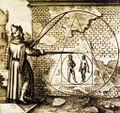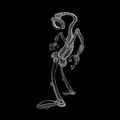Template:Selected anniversaries/January 31: Difference between revisions
No edit summary |
No edit summary |
||
| Line 11: | Line 11: | ||
||1839: Fox Talbot read a paper before the Royal Society, London, to describe his photographic process using solar light, with an exposure time of about 20 minutes: Some Account of the Art of Photogenic Drawing or the Process by which Natural Objects may be made to Delineate Themselves without the Aid of the Artist's Pencil. Pic. | ||1839: Fox Talbot read a paper before the Royal Society, London, to describe his photographic process using solar light, with an exposure time of about 20 minutes: Some Account of the Art of Photogenic Drawing or the Process by which Natural Objects may be made to Delineate Themselves without the Aid of the Artist's Pencil. Pic. | ||
|| | ||1862: Alvan Graham Clark discovers the white dwarf star Sirius B, a companion of Sirius, through an 18.5-inch (47 cm) telescope now located at Northwestern University. Pic. | ||
|| | ||1868: Theodore William Richards born ... chemist and academic, Nobel Prize laureate. Pic (cool tech). | ||
||1881: Irving Langmuir born ... chemist and physicist, Nobel Prize laureate. Pic. | |||
||1881: Irving Langmuir born ... chemist and physicist, Nobel Prize laureate. | |||
||1886: Mathematician and academic George Neville Watson born. He will apply complex analysis to the theory of special functions. In 1918 he proved a significant result known as Watson's lemma, that has many applications in the theory on the asymptotic behaviour of exponential integrals. Pic search: https://www.google.com/search?q=george+neville+watson | ||1886: Mathematician and academic George Neville Watson born. He will apply complex analysis to the theory of special functions. In 1918 he proved a significant result known as Watson's lemma, that has many applications in the theory on the asymptotic behaviour of exponential integrals. Pic search: https://www.google.com/search?q=george+neville+watson | ||
||1896: Sofya Yanovskaya born ... mathematician and historian. | ||1896: Sofya Yanovskaya born ... mathematician and historian. Pic. | ||
||1898: John "Jack" Roland Redman born ... admiral in the United States Navy. A naval communications officer, he played key roles in signals intelligence during World War II in Washington, D.C., and on the staff of Admiral Chester W. Nimitz. | ||1898: John "Jack" Roland Redman born ... admiral in the United States Navy. A naval communications officer, he played key roles in signals intelligence during World War II in Washington, D.C., and on the staff of Admiral Chester W. Nimitz. Pic search: https://www.google.com/search?q=John+"Jack"+Roland+Redman&oq=John+"Jack"+Roland+Redman | ||
||1903: Mathematician and academic Norman Macleod Ferrers dies. In 1871 he first suggested to extend the equations of motion with nonholonomic constraints.[4] His another treatise on "Spherical Harmonics," published in 1877, presented many original features. In 1881 he studied Kelvin's investigation of the law of distribution of electricity in equilibrium on an uninfluenced spherical bowl and made the addition of finding the potential at any point of space in zonal harmonics. Pic. | ||1903: Mathematician and academic Norman Macleod Ferrers dies. In 1871 he first suggested to extend the equations of motion with nonholonomic constraints.[4] His another treatise on "Spherical Harmonics," published in 1877, presented many original features. In 1881 he studied Kelvin's investigation of the law of distribution of electricity in equilibrium on an uninfluenced spherical bowl and made the addition of finding the potential at any point of space in zonal harmonics. Pic. | ||
| Line 33: | Line 31: | ||
||1915: World War I: Germany is the first to make large-scale use of poison gas in warfare in the Battle of Bolimów against Russia. | ||1915: World War I: Germany is the first to make large-scale use of poison gas in warfare in the Battle of Bolimów against Russia. | ||
||1928: Irma Wyman born ... computer | ||1928: Irma M. Wyman born ... early computer engineer and the first woman to become vice president of Honeywell, Inc. She was a systems thinking tutor and was the first female CIO of Honeywell. Pic search: https://www.google.com/search?q=Irma+Wyman | ||
||1929: Rudolf Mössbauer born ... physicist and academic, Nobel Prize laureate. | ||1929: Rudolf Mössbauer born ... physicist and academic, Nobel Prize laureate. Pic. | ||
File:Werner Heisenberg.jpg|link=Werner Heisenberg (nonfiction)|1933: Physicist and crime-fighter [[Werner Heisenberg (nonfiction)|Werner Heisenberg]] uses the [[Uncertainty principle (nonfiction)|uncertainty principle]] to detect and prevent [[crimes against mathematical constants]]. | File:Werner Heisenberg.jpg|link=Werner Heisenberg (nonfiction)|1933: Physicist and crime-fighter [[Werner Heisenberg (nonfiction)|Werner Heisenberg]] uses the [[Uncertainty principle (nonfiction)|uncertainty principle]] to detect and prevent [[crimes against mathematical constants]]. | ||
| Line 43: | Line 41: | ||
||1937: Anatoly Alexeevitch Karatsuba born ... mathematician working in the field of analytic number theory, p-adic numbers and Dirichlet series. The Karatsuba algorithm is the earliest known divide and conquer algorithm for multiplication and lives on as a special case of its direct generalization, the Toom–Cook algorithm. Pic. | ||1937: Anatoly Alexeevitch Karatsuba born ... mathematician working in the field of analytic number theory, p-adic numbers and Dirichlet series. The Karatsuba algorithm is the earliest known divide and conquer algorithm for multiplication and lives on as a special case of its direct generalization, the Toom–Cook algorithm. Pic. | ||
||1950: United States President Harry S. Truman announces a program to develop the hydrogen bomb. | ||1950: United States President Harry S. Truman announces a program to develop the hydrogen bomb. Pic. | ||
||1954: Edwin Howard Armstrong dies ... electrical engineer and inventor, best known for developing FM (frequency modulation) radio and the superheterodyne receiver system. Pic. | ||1954: Edwin Howard Armstrong dies ... electrical engineer and inventor, best known for developing FM (frequency modulation) radio and the superheterodyne receiver system. Pic. | ||
| Line 56: | Line 54: | ||
||1966: The Soviet Union launches the unmanned Luna 9 spacecraft as part of the Luna program. | ||1966: The Soviet Union launches the unmanned Luna 9 spacecraft as part of the Luna program. | ||
||1968: Theoretical physicist and | ||1968: Theoretical physicist and academic Earle Hesse Kennard dies. Much of his research for the Navy focused on hydrodynamics and elasticity, in particular on the theory of potential flow, the physics of underwater explosions and structural vibrations. Pic search: https://www.google.com/search?q=Earle+Hesse+Kennard | ||
||1971: Apollo program: Apollo 14: Astronauts Alan Shepard, Stuart Roosa, and Edgar Mitchell, aboard a Saturn V, lift off for a mission to the Fra Mauro Highlands on the Moon. | ||1971: Apollo program: Apollo 14: Astronauts Alan Shepard, Stuart Roosa, and Edgar Mitchell, aboard a Saturn V, lift off for a mission to the Fra Mauro Highlands on the Moon. | ||
Revision as of 17:06, 31 January 2019
1632: Clockmaker and mathematician Jost Bürgi dies. He was recognized during his own lifetime as one of the most excellent mechanical engineers of his generation.
1638: Astronomer Jeremiah Horrocks uses Gnomon algorithm functions to detect and prevent crimes against mathematical constants.
1933: Physicist and crime-fighter Werner Heisenberg uses the uncertainty principle to detect and prevent crimes against mathematical constants.
1971: The Winter Soldier Investigation, organized by the Vietnam Veterans Against the War to publicize war crimes and atrocities by Americans and allies in Vietnam, begins in Detroit.
2001: American comic book artist Gil Kane dies.
2002: Anarchimedes uses Gnomon algorithm to commit crimes against mathematical constants.
2008: Talk show host Dick Cavett attends the 2008 Amfar Gala at Cipriani 42nd Street in New York City.
2018: Steganographic analysis of Creature unexpectedly generates cryptographic numina.








